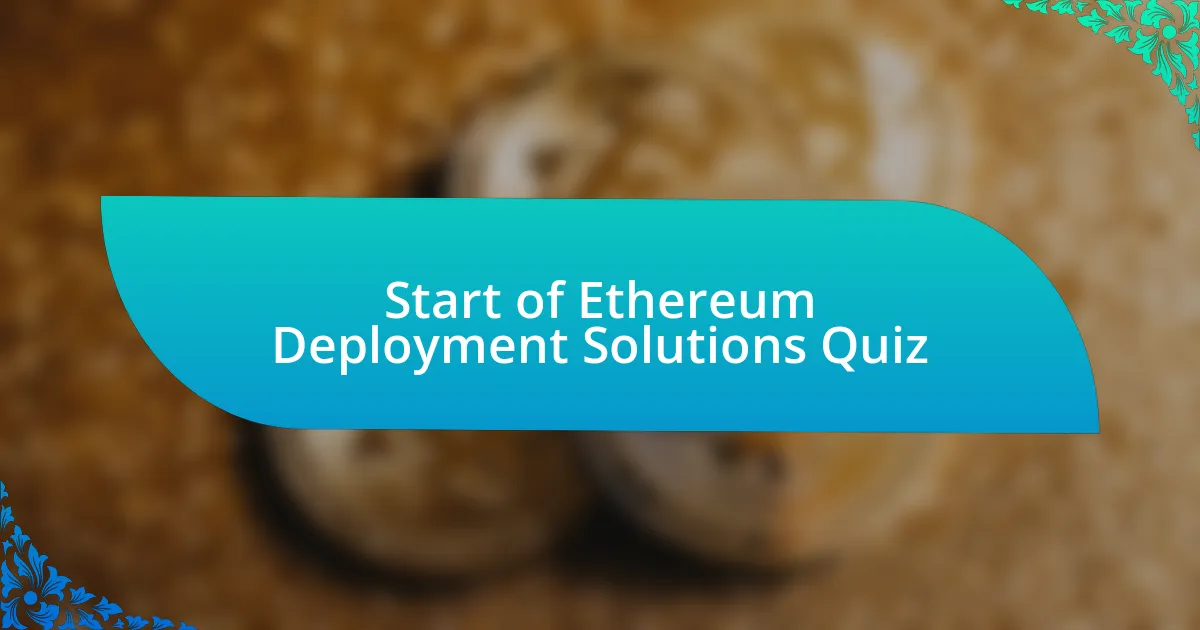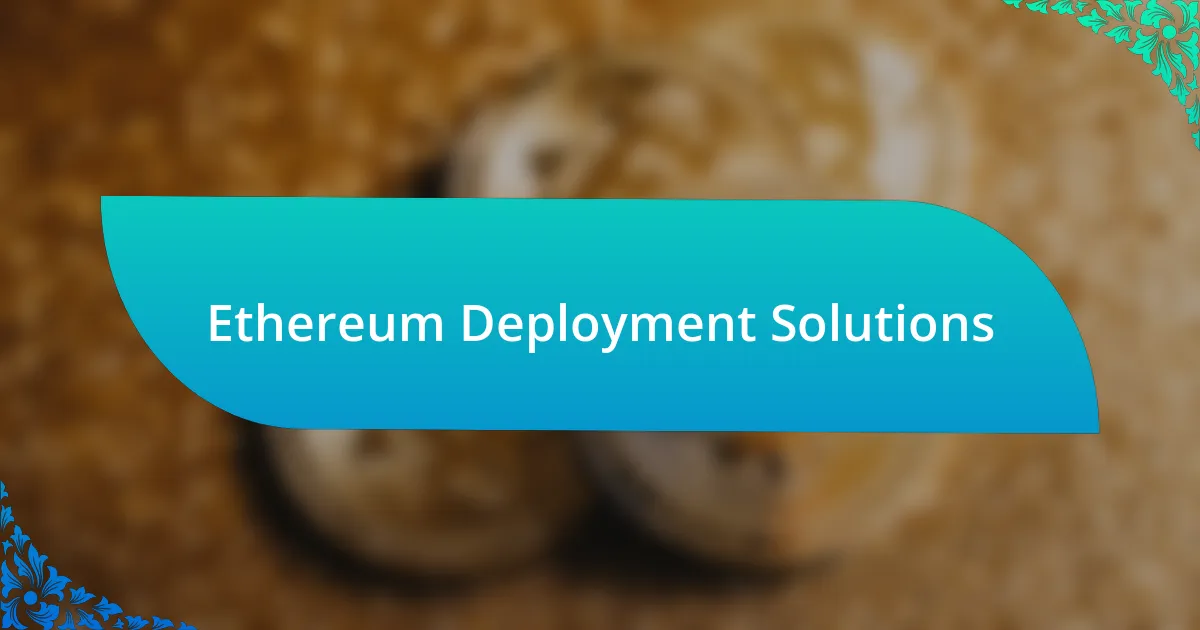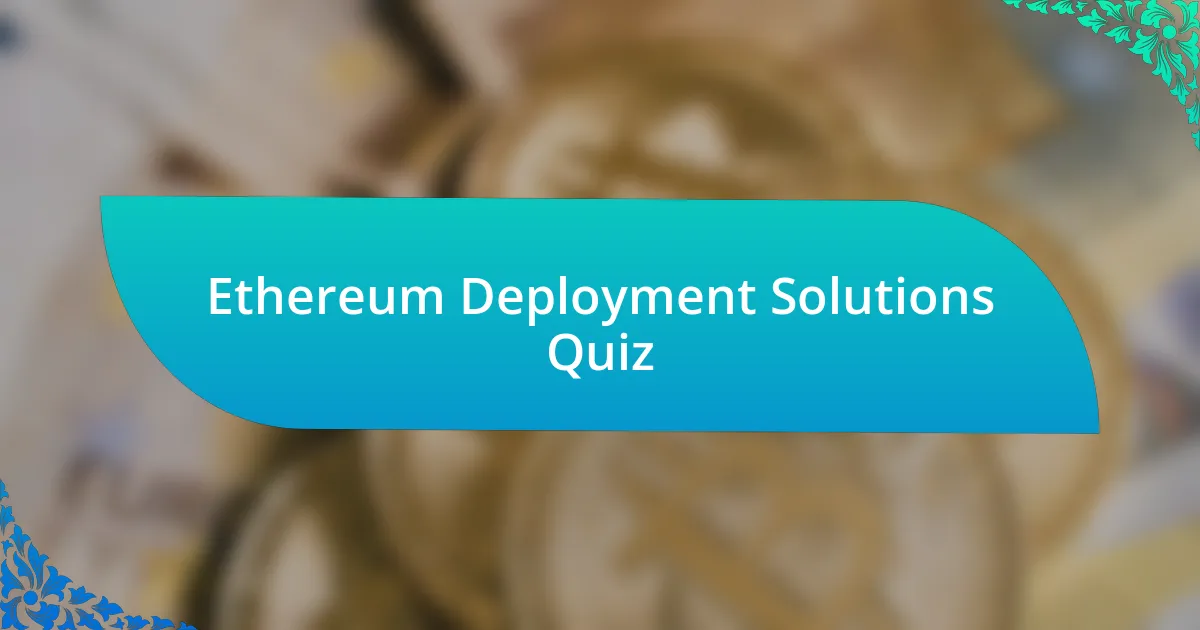
Start of Ethereum Deployment Solutions Quiz
1. What is the first step in deploying a smart contract on Ethereum?
- Compiling the contract into bytecode.
- Writing the contract in C++.
- Deploying the contract to a test network.
- Creating the user interface for the contract.
2. How is the bytecode of a smart contract stored on the Ethereum blockchain?
- The bytecode is stored on the blockchain in the memory of miners.
- The bytecode is stored on the blockchain after it is deployed, and an address is assigned to it.
- The bytecode is stored in a temporary cache until the next block is mined.
- The bytecode is kept in a private database that is not accessible publicly.
3. What is the purpose of the sender address and nonce in determining the contract address?
- The sender address uses base58 encoding to generate the contract address.
- The sender address and nonce are concatenated without any encoding to create the contract address.
- The sender address and nonce are RLP encoded and hashed with the keccak-256 algorithm to determine the contract address.
- The sender address is ignored, and the contract address is randomly assigned.
4. What is Remix IDE used for in Ethereum smart contract deployment?
- Remix IDE is used to analyze blockchain data and trends.
- Remix IDE is used to create digital wallets for managing Ether.
- Remix IDE is used to deploy, test, and develop smart contracts.
- Remix IDE is used to mine Ethereum and validate transactions.
5. How do you deploy a smart contract using Remix IDE?
- You deploy a smart contract using Remix IDE by downloading a special Ethereum wallet and sending the contract code via email.
- You deploy a smart contract using Remix IDE by selecting `Deploy` from the dropdown under `Environment,` approving the transaction from MetaMask, and then clicking `Deploy.`
- You deploy a smart contract using Remix IDE by selecting `Compile` from the menu and waiting for the next block confirmation.
- You deploy a smart contract using Remix IDE by writing a deployment script in Python and executing it in a terminal.
6. What tools can be used to deploy smart contracts on Ethereum?
- Docker
- Remix
- GitHub
- Kubernetes
7. What is the role of gas in deploying a smart contract?
- Gas is used to generate the unique address for the smart contract.
- Gas is used to pay for the transaction costs associated with deploying a smart contract.
- Gas is used to verify the smart contract`s code before deployment.
- Gas is used to store the smart contract on the blockchain permanently.
8. How do you create a deployment script for deploying a smart contract?
- You create a deployment script by developing a C++ application to compile and deploy the contract.
- You create a deployment script by making a simple JS script that uses a Tenderly DevNet to access the blockchain and publish the compiled bytecode.
- You create a deployment script by writing a Python script that runs on a local blockchain node.
- You create a deployment script by using a SQL command to insert the contract into the blockchain database.
9. What is Tenderly DevNet used for in smart contract deployment?
- Tenderly DevNet is used to analyze gas prices in Ethereum transactions.
- Tenderly DevNet is used to access the blockchain and publish compiled bytecode for smart contract deployment.
- Tenderly DevNet is used for generating user interfaces for smart contracts.
- Tenderly DevNet is used for creating decentralized applications without smart contracts.
10. How do you deploy a smart contract using Hardhat?
- You deploy a smart contract using Hardhat by packaging all dependencies in a zip file and sending it to the Ethereum network.
- You deploy a smart contract using Hardhat by saving the file in the contracts directory and compiling it with Remix.
- You deploy a smart contract using Hardhat by creating a GUI that connects to Metamask and allowing users to input their contracts.
- You deploy a smart contract using Hardhat by writing a script that deploys the contract via ethers.js and invoking it using `$ npx hardhat run scripts/deploy.ts.`
11. What is the purpose of the private key in deploying a smart contract?
- The private key is used to sign the transaction that contains the contract bytecode.
- The private key verifies the identity of the smart contract itself.
- The private key sets the gas limit for the transaction.
- The private key encrypts the contract code before deployment.
12. What is Infura used for in Ethereum node services?
- Infura is used as an Ethereum node service to access the blockchain.
- Infura is used to develop decentralized applications.
- Infura is used to mine Ethereum blocks.
- Infura is used to create Ethereum tokens.
13. How do you connect MetaMask to Infura for deployments?
- You connect MetaMask to Infura by installing an Infura extension in the browser.
- You connect MetaMask to Infura by selecting Infura from the dropdown under “Environment” in Remix IDE.
- You connect MetaMask to Infura by entering your Infura API key in MetaMask settings.
- You connect MetaMask to Infura by running a local node and linking it to MetaMask.
14. What is Truffle Teams used for in deploying smart contracts?
- Truffle Teams is used to connect MetaMask for deployments, allowing full control over gas prices and speeding up transactions.
- Truffle Teams is used to audit smart contracts for security vulnerabilities.
- Truffle Teams is used to test smart contracts after deployment.
- Truffle Teams is used to compile smart contracts before deployment.
15. What is the Truffle-flattener used for?
- The Truffle-flattener is used to optimize gas fees for transactions.
- The Truffle-flattener is used to create user interfaces for web applications.
- The Truffle-flattener is used to get deployable contracts for Remix from Truffle.
- The Truffle-flattener is used to manage Ethereum node connections.
16. How do you deploy a smart contract using Web3?
- You deploy a smart contract using Web3 by sending Ether to the contract address before it is created.
- You deploy a smart contract using Web3 by manually editing the Ethereum blockchain ledger.
- You deploy a smart contract using Web3 by calling a function from an existing contract that handles deployment.
- You deploy a smart contract using Web3 by creating a new contract instance and calling the `deploy` method with the bytecode and constructor arguments.
17. What is the average block time in Ethereum?
- 14 seconds
- 20 seconds
- 25 seconds
- 10 seconds
18. What is the block size limit in Ethereum?
- 2 KB
- 500 KB
- 10 KB
- 1 MB
19. Can transactions be kept hidden on the public Ethereum network?
- Yes, all transactions can be made secret.
- Yes, transactions can be obscured with encryption.
- No, only some transactions are visible to the public.
- No, all transactions on the public Ethereum network are public.
20. How does gas work in Ethereum transactions?
- Gas is used as an internal pricing mechanism in Ethereum transactions, and it is required to pay for the execution of smart contracts.
- Gas is a type of cryptocurrency used in Ethereum transactions.
- Gas is a fixed fee paid to miners regardless of transaction complexity.
- Gas is only needed for transferring Ether between addresses.
21. What happens if gas runs out without the transaction being complete?
- All state changes are reversed, and the used gas is given to the miner.
- The transaction becomes permanent and cannot be undone.
- The transaction is automatically re-submitted with higher gas.
- The contract is deployed without needing any gas.
22. What is the role of MetaMask in Ethereum smart contract deployment?
- MetaMask is used to interact with the Ethereum network, connect to Infura, and manage gas prices during deployments.
- MetaMask is used to generate Ethereum addresses without transactions.
- MetaMask is used to create blockchain nodes for other developers.
- MetaMask is used to compile smart contracts into bytecode during deployments.
23. How do you speed up or cancel pending transactions using MetaMask?
- You can speed up or cancel pending transactions using MetaMask by selecting the transaction and choosing the desired action.
- You can ignore pending transactions to have them processed faster by the network.
- You can only cancel pending transactions by restarting your MetaMask wallet.
- You can speed up transactions by waiting for the next block confirmation.
24. What is the purpose of the Hardhat-deploy plugin?
- The Hardhat-deploy plugin automatically generates Solidity code for smart contracts.
- The Hardhat-deploy plugin adds the capability to store finished deployments in files.
- The Hardhat-deploy plugin helps in debugging contract code during development.
- The Hardhat-deploy plugin creates a graphical interface for contract interactions.
25. What is the difference between deploying to mainnet and deploying to a test network?
- Mainnet deployments do not require gas fees at all.
- Test network deployments are always faster than mainnet deployments.
- Deploying to mainnet requires real Ether for gas, while deploying to a test network can use free Ether.
- Both mainnet and test network deployments require real Ether.
26. How do you deploy a smart contract using Truffle Teams?
- You deploy a smart contract using a CLI tool with no connection to a wallet.
- You deploy a smart contract using Truffle Teams by connecting MetaMask and using the project dashboard to manage deployments.
- You deploy a smart contract by writing a Python script and running it on local servers.
- You deploy a smart contract by compiling it directly on the Ethereum blockchain.
27. What is the role of Tenderly in smart contract development and deployment?
- Tenderly provides debugging, observability, and infrastructure support for smart contracts.
- Tenderly compiles smart contracts into bytecode for deployment.
- Tenderly acts as a wallet for managing Ether and transactions.
- Tenderly connects directly to Infura for blockchain access.
28. What is the purpose of the `deploy` method in Web3?
- The `deploy` method in Web3 is used to deploy a smart contract by sending a transaction containing the contract bytecode.
- The `deploy` method in Web3 is used to create a new Ethereum account.
- The `deploy` method in Web3 is used to query the current state of a smart contract.
- The `deploy` method in Web3 is used to transfer Ether between accounts.
29. How do you compile a smart contract for deployment?
- You compile a smart contract by manually inserting the code into the Ethereum blockchain.
- You compile a smart contract by uploading it to a web server for processing.
- You compile a smart contract by writing JavaScript code that represents the contract.
- You compile a smart contract by using a Solidity compiler to convert the contract code into bytecode.
30. What is the difference between Remix and Hardhat in smart contract deployment?
- Remix focuses on JavaScript coding, while Hardhat deals with Python smart contracts.
- Remix is only for testing, while Hardhat supports only deployment.
- Remix is used for blockchain analysis, while Hardhat is designed for front-end development.
- Remix is a browser-based IDE for quick mainnet deployments, while Hardhat is a development environment for compiling, deploying, testing, and debugging Ethereum software.

Congratulations! You’ve Completed the Ethereum Deployment Solutions Quiz
Well done on completing the quiz about Ethereum Deployment Solutions! It’s great to see your commitment to learning about such an important topic in the world of blockchain technology. By engaging with this quiz, you have deepened your understanding of various deployment methods, smart contract management, and the intricacies of Ethereum’s ecosystem. Each question was an opportunity to explore the practical applications and challenges you may encounter in deploying Ethereum solutions.
Throughout this quiz, you may have discovered key concepts surrounding Ethereum networks, tools like Truffle and Hardhat, and best practices for ensuring successful deployments. These insights are crucial for anyone looking to work with Ethereum or develop decentralized applications. The knowledge you’ve gained will serve as a solid foundation for navigating future projects in the ever-evolving space of blockchain development.
Now that you’ve finished the quiz, we invite you to dive deeper into the topic. Check out the next section on this page, where you will find a wealth of information about Ethereum Deployment Solutions. This additional material will help expand your knowledge even further, enabling you to tackle more complex challenges with confidence. Happy learning!

Ethereum Deployment Solutions
Overview of Ethereum Deployment Solutions
Ethereum deployment solutions refer to tools and platforms that facilitate the launch and management of decentralized applications (dApps) on the Ethereum blockchain. These solutions simplify the process of deploying smart contracts, providing essential functionalities like testing, debugging, and monitoring. Popular solutions often include frameworks and services tailored to enhance development efficiency and reduce deployment risks.
Ethereum Development Frameworks
Development frameworks serve as foundational tools for building, testing, and deploying Ethereum applications. Notable frameworks include Truffle, Hardhat, and Brownie. These frameworks allow developers to write and test smart contracts in a structured environment while providing features such as automated testing, deployment scripts, and interaction with Ethereum nodes, thus streamlining the development lifecycle.
Hosting Solutions for Ethereum Applications
Hosting solutions provide the infrastructure needed to run Ethereum dApps. These services include options like Infura and Alchemy, which offer robust APIs to connect to Ethereum networks without requiring users to manage their own nodes. They enhance accessibility and scalability, allowing applications to efficiently access and interact with the blockchain, thereby supporting high user demand.
Decentralized Deployment Tools
Decentralized deployment tools enable developers to launch applications directly on the blockchain without relying on centralized servers. Examples include tools like Fleek and IPFS. These platforms ensure that deployed applications have high availability and resistance to censorship, preserving the decentralized ethos of Ethereum and providing a trustworthy environment for users to interact with dApps.
Security Measures in Ethereum Deployment Solutions
Security measures are critical in Ethereum deployment solutions to protect smart contracts from vulnerabilities. Solutions may involve tools like MythX or Slither for static analysis, and auditing services by firms such as ConsenSys Diligence. Implementing these measures helps identify and mitigate potential exploits, ensuring the integrity and reliability of deployed applications on the Ethereum network.
What are Ethereum Deployment Solutions?
Ethereum deployment solutions are frameworks or services that facilitate the process of launching decentralized applications (dApps) on the Ethereum blockchain. They allow developers to deploy smart contracts and manage their interactions within the Ethereum ecosystem. Popular examples include tools like Truffle, Hardhat, and Infura, which provide functionalities such as testing, deployment, and enhanced connectivity to the Ethereum network.
How do Ethereum Deployment Solutions work?
Ethereum deployment solutions work by providing developers with the necessary tools to write, compile, and deploy smart contracts onto the Ethereum blockchain. These solutions typically include integrated development environments (IDEs) that support Solidity, the primary programming language for Ethereum. After code is written and tested, deployment solutions facilitate the interaction with the Ethereum network to broadcast the smart contract to achieve consensus among nodes, ensuring its permanence and security.
Where can Ethereum Deployment Solutions be utilized?
Ethereum deployment solutions can be utilized in various sectors, including finance, gaming, supply chain management, and social networking. They are ideal for developers who are building applications that require decentralized trust and transparency, such as decentralized finance (DeFi) platforms and non-fungible token (NFT) marketplaces. These solutions enable the deployment and management of a wide range of dApps across the Ethereum network.
When should developers use Ethereum Deployment Solutions?
Developers should use Ethereum deployment solutions during the development and launch phases of their dApps. These solutions are especially useful when preparing smart contracts for public deployment on the Ethereum mainnet, as they streamline the process of testing, debugging, and deploying code. Utilizing these tools ensures that developers can efficiently manage updates and interact with decentralized networks effectively.
Who benefits from Ethereum Deployment Solutions?
Developers, startups, and established companies benefit from Ethereum deployment solutions. Developers gain access to streamlined processes for building dApps, while startups can accelerate their development timeline. Established companies looking to innovate or transition to blockchain technologies also find value, as these solutions reduce complexity and operational overhead associated with deploying on the Ethereum blockchain.

